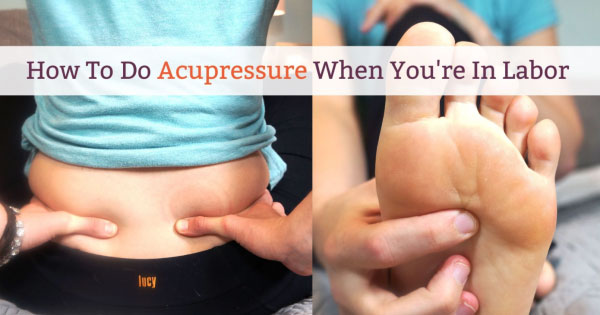As far back as 5,000 years ago, acupressure has been used to help relieve pain in laboring women. Now, more and more people are using it as a valuable tool in their labour toolkit. But when do you use it? And where do you press? And how do you do it?

Here is everything you need to know.
The Basis of Acupressure
Acupressure is based on the principles of acupuncture, which is a form of Traditional Chinese Medicine. It involves the application of pressure to specific points on the body. It is not massage, but rather a direct, firm pressure to a specific area. You can use your fingers, thumbs, knuckles, elbows, the blunt end of a pencil or pen or other hard, round objects.
Acupressure on these certain points can be used to start labour, as certain points are known to increase the release of oxytocin, which is your labour hormone. Oxytocin is what causes labour contractions. Acupressure can also be used to strengthen or re-start a stalling labour, again due to its connection with oxytocin. Acupressure can be used as pain relief in a vaginal birth, as certain points have been proven to have an analgesic effect. And lastly, acupressure is used to calm a birthing woman.
So, as you can see, it’s a very useful tool to have during childbirth.
When To Use It?
If you plan on using acupressure during your labour, practice it beforehand – and often. All the points are safe from week 37 on, but you’ll want to use less pressure than you would during your labor. When you’re in labor, you want to press firmly on the point. The sensation should be tolerable but you should definitely feel a strong pressure. You might feel pressure, heaviness or even an electrical sensation on the point. If you have a support person for your birth, you will want to practice with them beforehand so they understand the pressure to apply and what feels right to you.
It is very helpful to start using acupressure in the early stages of labour and continue at regular intervals to help the success of acupressure in the intense, later stages of labour. Many women use it for every contraction, so that when they feel one coming, they have their birth support person press firmly on their sacral acupressure points and it greatly relieves the intensity of the contraction sensation.
When your support person is giving you acupressure during labour, keep experimenting and give clear feedback about what’s working the best. “Harder” “Softer” “Lower” “Now” are ways you can get across just how and when you need your support person to help you.
The Acupressure Points
There are several points where pressure can be applied for pain relief and for an efficient birth. Again, make sure there is direct, firm pressure on the points. Everyone is different on how long they like the points to be held for and how often. This is completely up to the labouring woman.
Large Intestine 4
This point is great to help get labour started and the woman is able to press this point herself. It’s generally helpful for her to start pressing this point at the beginning of labour (or even before it begins in the last couple weeks of pregnancy). This point is often useful when the woman starts to get the urge to push. Press around until you feel a dull ache. That’s when you know you’re on the point.
Lower Back/Sacral Points
The lower back points are extremely helpful if you are experiencing an intense contraction and they are used as a counter pressure, especially if you feel it in your lower back. These points are located in the lower back region and can be individualized to the laboring woman depending on where it feels the best to her. Sometimes the point might be more outwards on the lower back. Have your support person push into the points with their knuckles and lean in with their body weight during a contraction. Clearly inform them where the point needs to be – you’ll feel it – by using words like “higher, “lower” “go right” “harder”, etc.
Kidney 1
This point is located in the center of sole of the foot in the depression next to the bottom of the ball of the foot. These points pull energy downward and are typically useful during the transition phase of labour. This is also a great point for calming to help with stress and anxiety. Your support person could press on it tenderly in between contractions to keep a woman centred and calm.
Spleen 6
This point is located on the inner calf about four fingers width up along the tibial bone. There will be a tender spot, so find that. In case of a stalling labour, use this point along with large intestine 4 to encourage stronger contractions. Have the woman apply pressure to the hand point and the support person give acupressure to spleen 6.
You’ll have to experiment with each of these points to see which ones feel the best. What felt the best during pregnancy might not be the one that feels the best during labour and they could also change depending on what phase of labour you’re in.
Final Thoughts About Acupressure During Labor
Acupressure has been practised for thousands of years. Countless women say it’s helped them jump start labour, relieve pain, strengthen contractions, and simply gave them a tool to help them feel more centred and in control.
Best of all, acupressure is safe and gives your support person a very tangible way to help you during labour, connecting them more to the process, and to you. If you’re looking for natural pain relief during labor, it’s definitely worth learning how to do acupressure and giving it a try.
Our acupuncture practitioners can certainly help you locate the points and teach you acupressure if you are unsure.

